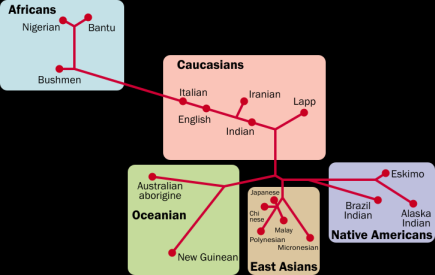
Exploring the history and experiences of mixed heritage persons and inter-racial relationships across the world

Exploring the history and experiences of mixed heritage persons and inter-racial relationships across the world
The growing scientific field of genetics is challenging many of the most widely used human racial categories which are based on combinations of visible characteristics such as skin colour, eye shape and hair texture. Based on scientific work and discussion, the American Anthropological Association's 'Statement on Race' in1998 stated 'so-called racial groups are not consequences of their biological inheritance but products of historical and contemporary social, economic, educational, and political circumstances'. In other words, race is socially defined and how those definitions are used is a purely a social matter.
 All human beings are the same species and the difficulty of genetically classifying people by race is due to the fact that nature has not created distinct, non-overlapping genetic groups of people. In neighbouring populations there is much overlapping of genes, blending from individual to individual, from society to society. There is scientific evidence showing that some 94% of physical variation lies within groups and that distinct racial grouping differ from one another only in about 6% of their genes. In fact, the Human Genome Project states "two random individuals from any one group are almost as different as any two random individuals from the entire world".
All human beings are the same species and the difficulty of genetically classifying people by race is due to the fact that nature has not created distinct, non-overlapping genetic groups of people. In neighbouring populations there is much overlapping of genes, blending from individual to individual, from society to society. There is scientific evidence showing that some 94% of physical variation lies within groups and that distinct racial grouping differ from one another only in about 6% of their genes. In fact, the Human Genome Project states "two random individuals from any one group are almost as different as any two random individuals from the entire world".
This has not stopped some from trying to identify genetic traits that are specific to populations. One method incorporates statistical 'similarities' in genetic make-up to geographic origin or ancestry. Based on some 326 markers known as microsatellites, short strips of genes which are normally neutral, a 2005 'clustering' study came up with some results that attempted to identify population clusters. Due to the nature of the continuous genetic difference, the study used distinct separate populations separated by considerable geographical distances.
Another method is the calculation of genetic distance which is a measure used to differentiate the frequency of a particular observable trait between two populations. However when one trait is used there is no significant genetic difference between populations; again the result of continual genetic mutations. To get round this limitation, the average values of several different traits are compared together in other words, clustered. One such study in 1994 evaluated the genetic distances between 42 populations from around the world based on 120 blood differences.
Both these studies mentioned gave very similar results and that should not be a surprise considering that the tests themselves are rather similar. Remember there is no hierarchy of any sort in these results; it is a series of gradual non-linear changes from one end of a spectrum to another.
| Clustering Study | Africa->Europe->Middle East->Central & South Asia->East Asia->Oceania->Americas |
| Genetic Distance | African->Non-European Caucasian->European Caucasian->North East Asian->Artic North East Asian->Amerindian->South East Asian->Pacific Islander->New Guinean/Australian |
Two major interesting features are highlighted by the results of both studies. Both the Oceania people and the Native Americas are genetically distant from the Africans at the other end, as can be expected due to land distance, but the studies' results have them in reverse orders. I quite suspect the missing link in one study is the inclusion of the Australasian - the New Guinea and Australian Aborigine - in the Oceanic group. Wouldn't it just be a wonderful fact that both ends of the human genetic spectrum have people of similar visual appearance despite the fact that the those traits evolved separately in a process known as convergent evolution?
 The other is the relative closeness of the sub-Saharan African and the Caucasian, the black and the white. The accepted assumption that there are white people and then the others of various darker skin shades seem to have its basis in the caste system of colonial Spanish America. Despite its encouragement of miscegenation - another word for inter-racial mixing - many upper class Spanish colonialists eventually brought their white Spanish wives to the colonies. This led to the classification of white racial purity at the top of society's structure and those with varying degrees of whiteness below that and at the bottom was the native Indian and slave African. This view is so prevalent that so many societies today still view lighter skin colour as being superior.
The other is the relative closeness of the sub-Saharan African and the Caucasian, the black and the white. The accepted assumption that there are white people and then the others of various darker skin shades seem to have its basis in the caste system of colonial Spanish America. Despite its encouragement of miscegenation - another word for inter-racial mixing - many upper class Spanish colonialists eventually brought their white Spanish wives to the colonies. This led to the classification of white racial purity at the top of society's structure and those with varying degrees of whiteness below that and at the bottom was the native Indian and slave African. This view is so prevalent that so many societies today still view lighter skin colour as being superior.
When the admixture populations of North Africa and West Asia are ignored, Europe does in fact have the closest genetic distance from Africa, all non-African groups including Europeans relate closer to each other than to sub-Saharan Africans. Outside of Africa, the people living in the wide crescent of land stretching from the eastern shore of the Mediterranean to northern India have the greatest genetic diversity proving the age of the populations and the result of many admixtures.
The results of our two studies are a little misleading though. There is not really a linear gradation from one end of the spectrum to the other but more of a web of connections gradually moving apart. We have to bear in mind that studies like these do not do away with the difficulties of racially identifying individuals, both had to manage the tested populations to provide genetic distinction between them.
A word of warning, genetics is a rapidly growing field of study and changes to current accepted thinking are likely to happen on a regular basis. Scientists do disagree and sometimes conflicting evidence or arguments are publicised. It would be wise, if you are to use genetics for the basis of your beliefs to stay abreast of developments. I doubt we have heard the last of these in the area of race.
Further Reading
1. http://en.wikipedia.org/wiki/Race_and_genetics
2. http://en.wikipedia.org/wiki/Race_(classification_of_human_beings)
3. http://en.wikipedia.org/wiki/Social_interpretations_of_race
4. http://en.wikipedia.org/wiki/One-drop_rule
5. http://en.wikipedia.org/wiki/Miscegenation
6. http://www.guardian.co.uk/science/blog/2010/sep/09/gene-intelligence-genetic-testing
Other Resources
1. Clustering Results Image - http://en.wikipedia.org/wiki/File:9_Cluster_Tree.png
2. Genetic Distance Results Image - http://en.wikipedia.org/wiki/File:Rosenberg2007.png
3. 2002 Genetic Distance map - http://en.wikipedia.org/wiki/File:Neighbor-joining_Tree.svg